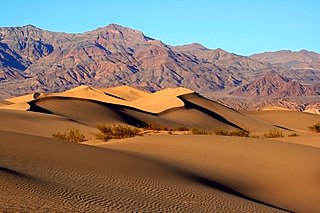
The Mojave Desert is a desert in the rain shadow of the southern Sierra Nevada mountains and Transverse Ranges in the Southwestern United States. Named for the indigenous Mohave people, it is located primarily in southeastern California and southwestern Nevada, with small portions extending into Arizona and Utah.

Cirsium occidentale, with the common name cobweb thistle or cobwebby thistle, is a North American species of thistle in the family Asteraceae.
Cymopterus aboriginum is a species of flowering plant in the carrot family known by the common name Indian springparsley.

Fagonia laevis, the California fagonbush, is a species of plant in the Zygophyllaceae, the caltrop family. It is a perennial subshrub of the southwestern United States and Northwestern Mexico desert regions in California, southern Nevada, Arizona, southwest Utah, Sonora, Baja California and Baja California Sur. It thrives upon hot, dry, slopes and hillsides that also receive seasonal-(winters of the Southwest) or monsoon moisture.

The Kiavah Wilderness is a federally designated wilderness area located in the Mojave Desert, Scodie Mountains, and southern Sierra Nevada in Kern County, California, United States. California State Route 178 connects the town of Lake Isabella to State Highway 14 in the east, crossing Walker Pass at the north boundary of the wilderness.
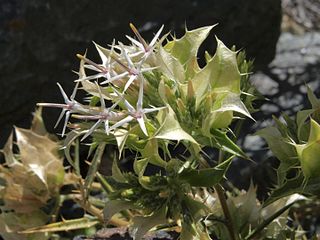
Hecastocleis is a genus of low thorny shrubs with stiff branches, assigned to the daisy family. At the tip of each of the branches, inflorescences are subtended by oval, thorny, whitish to greenish bracts that enclose several flower heads which each contain only one pinkish bud, opening into a white corolla. It contains but one species, Hecastocleis shockleyi, the only representative of the tribe Hecastocleideae, and of the subfamily Hecastocleidoideae. Its vernacular name is prickleleaf. It is confined to the southwestern United States.

Ageratina herbacea is a North American species of flowering plants in the family Asteraceae known by the common names fragrant snakeroot and Apache snakeroot. It is native to desert regions of the southwestern United States and northern Mexico. It grows in rocky slopes in conifer forests and woodlands.

Cirsium mohavense is a species of thistle known by the common names virgin thistle and Mojave thistle. It is native to the southwestern United States, where it grows in moist areas in otherwise dry habitat, such as desert springs. It is most common in the Mojave Desert, found also in the southern Great Basin and other nearby regions of California, Nevada, western Arizona, and southwestern Utah.

Encelia actoni, also known by the common names Acton brittlebush and Acton encelia, is a species of flowering plant in the family Asteraceae.

Monardella linoides is a species of flowering plant in the family Lamiaceae known by the common name flaxleaf monardella.

Penstemon azureus is a flowering plant species known by the common name azure penstemon. It is native to the mountains of Oregon and northern California. It grows in coniferous forests and woodlands in the Klamath Mountains, North California Coast Ranges, Southern Cascade Range, and Northern Sierra Nevada.

Penstemon caesius, commonly known as the San Bernardino penstemon, is a low growing species of flowering plant. It is endemic to California, where it is known from the San Bernardino and San Gabriel Mountains, as well as the southern mountains of the Sierra Nevada. It is a member of the flora on rocky slopes and in coniferous forests and alpine habitat in the mountains.

Penstemon eatonii is a species of flowering plant in the genus Penstemon, known by the common name firecracker penstemon. It is native to the Western United States from Southern California to the Rocky Mountains. It grows in many types of desert, woodland, forest, and open plateau habitat.
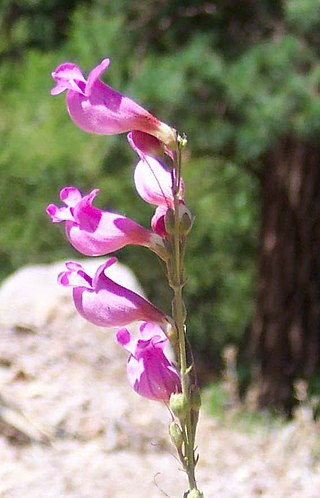
Penstemon floridus is a species of flowering plant in the plantain family known by the common names Panamint penstemon and rose penstemon.
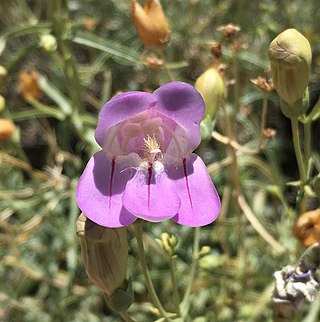
Penstemon fruticiformis is a species of penstemon known by the common name Death Valley penstemon. It is native to the western United States, where it is found growing in rocky scrub, woodlands, deserts and mountains of eastern California and western Nevada. It is known from scattered occurrences around Death Valley, and only one of the two varieties occurs on the Nevada side of the border.
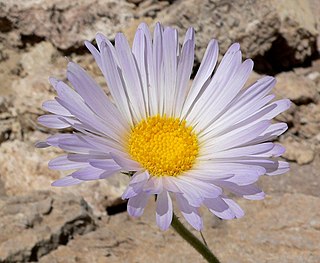
Xylorhiza tortifolia is a species of flowering plant in the family Asteraceae, known by the common names Mojave-aster and Mojave woodyaster.
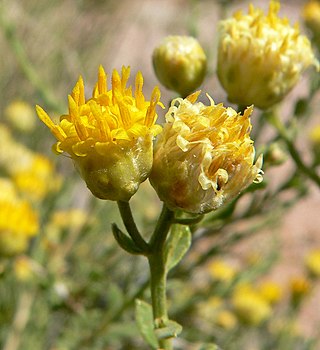
Acamptopappus sphaerocephalus is a species of flowering plant in the family Asteraceae known by the common name rayless goldenhead. It is native to the southwestern United States, where it occurs in southern California, southern Nevada, southern Utah, and Arizona.

Deinandra mohavensis, commonly known as Mojave tarplant or Mojave tarweed, is a species of flowering plant in the family Asteraceae.

The flora of the U.S. Sierra Nevada alpine zone is characterized by small, low growing, cushion and mat forming plants that can survive the harsh conditions in the high-altitude alpine zone above the timber line. These flora often occur in alpine fell-fields. The Sierra Nevada alpine zone lacks a dominant plant species that characterizes it, so may or may not be called a vegetation type. But it is found above the subalpine forest, which is the highest in a succession of recognized vegetation types at increasing elevations.



















